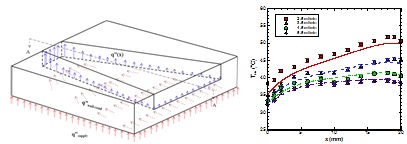
This microdevice is targeted towards the requirement of achieving isothermal condition in various lab-on-chip devices employed for chemical and biological processes. Typically, the cells have to be maintained at 37 oC whereas the lab temperature is 25 oC. When the temperature of the sample is to be raised one can either supply a uniform heat flux at the boundaries, or maintain the boundaries at a higher temperature. As is well known, for hydrodynamically and thermally fully-developed flow in simple geometries, a uniform heat flux leads to a linear increase in surface temperature, and a constant difference between the bulk fluid and wall temperatures. The presence of a lateral temperature gradient in the fluid however implies that the local fluid temperature can exceed the safe operating temperature limit. Maintaining the boundaries at a constant temperature is therefore the safer alternative where the local fluid temperature will necessarily be less than the wall temperature (in the wall heated case). At the conventional scale, the constant wall temperature condition is typically maintained by employing phase change. Maintaining constant temperature is however not simple, more so when extended to microscale. Moreover, only certain temperatures (and not any desired temperature) can be achieved with the phase change technique due to the limitations in the material that can be employed for this purpose.

We propose the idea of employing diverging microchannel in conjunction with wall conduction for this purpose (see figure). Isothermal wall condition for a supplied constant heat flux condition is demonstrated experimentally. Subsequently, it was studied in detail using three-dimensional numerical simulations to explore the idea over wider parameter range (angle, depth, length, thickness ratio, thermal conductivity thickness, mass flow rate, and heat flux). For the set of optimal parameters, diverging microchannel would yield a temperature gradient less than 0.05 °C/mm. The idea is further extended to obtain isotherm condition in series of diverging microchannels with application to thermo-cyclic processes like polymerize chain reaction (PCR).
Duryodhan, V., Singh, A., Singh, S.G., Agrawal, A.,
"A simple and novel way of maintaining constant wall temperature in microdevices," Nature Scientific Reports, Vol. 6, 18230, 2016.
Duryodhan, V., Singh, S.G., Agrawal, A.,
"Heat distribution in converging and diverging microchannel in presence of conjugate effect," International Journal of Heat and Mass Transfer, Vol 104, pp. 1022-1033, 2017.
Duryodhan, V., Singh, A., Singh, S.G., Agrawal, A.,
"Convective heat transfer in diverging and converging microchannels," International Journal of Heat and Mass Transfer, Vol. 80, pp. 424-438, 2015.
Duryodhan, V., Singh, S.G., Agrawal, A.,
"Liquid Flow through Converging Microchannel and Comparison with Diverging Microchannel," Journal of Micromechanics and Microengineering, Vol. 24, 125002 (1-13), 2014.
Duryodhan, V.S., Singh, S.G., and Agrawal, A.,
"Liquid flow in a diverging microchannel," Microfluidics and Nanofludics, Vol. 14, pp. 53-67, 2013.
Duryodhan, V., Singh, S.G., Agrawal, A.,
"Effect of cross aspect ratio on flow in diverging and converging microchannel," Journal of Fluids Engineering (under review).
References